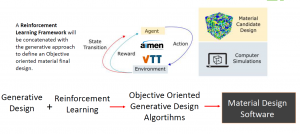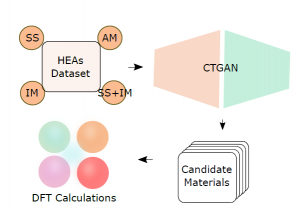![]() 24/01/2022
24/01/2022
Computational modelling and artificial intelligence progress
The very first part of the technical concept of ACHIEF initiative is providing an artificial intelligence aided toolbox. Therefore, from the beginning of the project, VTT along with CEA, AIMEN, TECNALIA, Constellium, ArcelorMittal, TRI, Seamthesis and TUPRAS have started working on the artificial intelligence (AI) aided toolbox. The AI toolbox will help partners to develop models for the mechanical, wear and chemical behaviour of the novel materials that are to be created.
Requirements for materials and coatings design
Firstly, CEA along with the partners developed a comprehensive list of specifications and operational parameters of each industrial process in the respective three demonstration sites. The partners also defined suitable indicators along with minimum target values and success criteria in order to evaluate the performance of the developed materials at lab scale. After the lab testing, the novel materials are to be implemented in three demonstration sites in France, Spain and Turkey to test their performance and efficiency.
Additionally, the consortium also defined key performance indicators. They will be used to characterize the new materials and coating solutions. More importantly, it will allow for comparison between current solutions for each respective application case.

Figure 1. The ACHIEF´s concept for integrated computer materials design engineering including data driven AI methodologies.
The parameters defined will be used as a starting point to feed into the rest of the project activities. More specifically, for the development and testing at lab-scale of Polymer Derived Ceramic (PDC) coatings, High Entropy Super Alloys (HESA) and Cr-steels, as well as the development and embedding of the sensors.
Generative model-aided High Entropy Super Alloys & Polymer Derived Ceramic design space
Apart from the operational parameters, AIMEN has developed a new data-based machine learning model. The consortium will use it to create new high entropy super alloy compositions and polymer derived ceramics to test them for high temperature strength and creep resistance.
Additionally, AIMEN has employed artificial intelligence (AI) to generate synthetic High Entropy Alloys (HEAs). To do so, AIMEN used algorithms from the Generative Adversarial Networks (GANs) family in order to generate the synthetic HEAs, thus creating new HEAs candidates. These generative models have learned from a dataset containing data of real samples, i.e., the algorithms were fed with available data from already existing HEAs found in the literature.
Moreover, AIMEN has created this training dataset by collecting information from different available sources. The dataset information relies on the chemical composition of the HEAs, their associated internal structure classified accordingly to their crystallinity, i.e., solid solution (SS), intermetallic (IM), both phases together SS+IM, and amorphous (AM). AIMEN has also included conventional design parameters for HEAs in the dataset, e.g., mixing entropy, valence electron concentration, bulk modulus, and melting temperature.
Thus, GANs were able to create realistic synthetic data by learning the relationship between the features present in the given dataset. AIMEN has used a conditional tabular generative adversarial network (CTGAN), a member of the GANs’ family in order to generate the final HEAs candidates as shown in Fig. 3.
AIMEN has verified the CTGAN output, i.e., the generated HEAs compositions, in density functional theory (DFT) based on open material databases. By these means, AIMEN has found that some of the generated compositions were found in these databases, possessing very similar features to the ones generated by the CTGAN. Experimentally proved HEAs compositions that were not used in the training dataset were also generated by this AI model, which can be seen as a validation for the results provided by this generative model.
Apart from the already literature/DFT-known generated compositions, novel HEAs candidates that are not found in the literature were also generated. Based on calculated mechanical and thermodynamic properties, such as Young’s modulus and melting temperature for these novel candidates, AIMEN will perform a screening to select the most promising HEAs to use for highly intensive energy industrial processes.

Figure 2. Process of selecting and verifying HEA candidates based on a HEAs dataset, the CTGAN model and density functional theory (DFT) calculations.
In more details, the ACHIEF partners will analyse the generated alloy compositions and their suitability for the defined demonstration case in France, Spain and Turkey. The analysis will be carried out with physics-based simulation tools and prior experience. Based on the results generated, the partners will implement new criteria and discriminator for to the machine-learning model. Thus, new candidate alloys will be produced. After a few performance tests, a new alloy composites will be selected.
Machine models-aided Creep steel design
VTT has developed a new machine learning model to also support the design of the new creep steel. The model is based on the data generated by a design of experiments done with JMatPro.
The new creep steel compositions are currently casting at lab scale. Once finalized, VTT will characterize the casted samples in order to generate data to finalize the models.
Micromechanical modelling of High Entropy Super Alloys & Cr-steel
Moreover, the consortium will use the generated knowledge so far with the characterisation data produced in other partners’ work activities in order to develop micromechanical models. ACHIEF will use these models to analyse the behaviour of the materials in the operational conditions. Furthermore, VTT and the partners will also look into the possibility to test how these different micromechanical features can be modified with manufacturing parameters (such as grain size) to affect the behaviour.
Modelling of the performance of Polymer Derived Ceramic
Led by VTT, this task has started in March 2021. The research team will be working on the modelling of the performance of Polymer Derived Ceramic (PDC) for the next 20 months. The main aim is studying the adhesion between the substrate and the coating at the operating temperature by using CALPHAD investigation. Thus, seeing which type of phases are formed between the matrix and the coating. Additionally, the phases within the coating are of interest as an input for the for the micromechanical modelling with finite element method. It will be used to investigate the possible delamination and the overall behavior during the operation.




